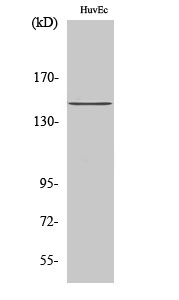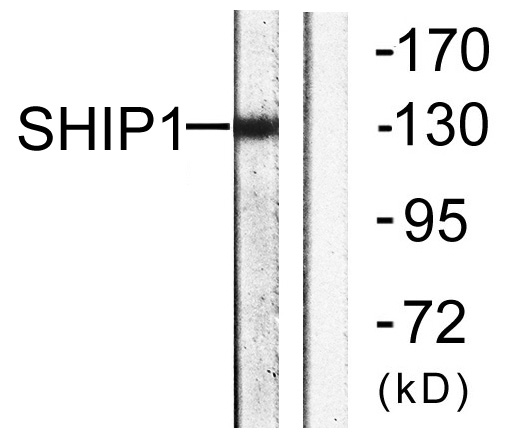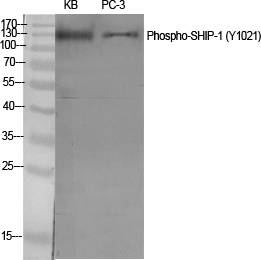
主要信息
Target
SHIP-1
Host Species
Rabbit
Reactivity
Human, Mouse, Rat
Applications
WB, IF, ELISA, IHC
MW
133kD (Observed)
Conjugate/Modification
Phospho
货号: YP0334
规格
价格
货期
数量
200μL
¥4,680.00
现货
0
100μL
¥2,800.00
现货
0
50μL
¥1,500.00
现货
0
加入购物车


已收藏


收藏
详细信息
推荐稀释比
WB 1:500-2000; IF/ICC1:50-200; ELISA 1:2000-20000; IHC 1:50-200
组成
Liquid in PBS containing 50% glycerol, 0.5% BSA and 0.02% sodium azide.
特异性
Phospho-SHIP-1 (Y1021) Polyclonal Antibody detects endogenous levels of SHIP-1 protein only when phosphorylated at Y1021.The name of modified sites may be influenced by many factors, such as species (the modified site was not originally found in human samples) and the change of protein sequence (the previous protein sequence is incomplete, and the protein sequence may be prolonged with the development of protein sequencing technology). When naming, we will use the "numbers" in historical reference to keep the sites consistent with the reports. The antibody binds to the following modification sequence (lowercase letters are modification sites):PLyGS
纯化工艺
The antibody was affinity-purified from rabbit antiserum by affinity-chromatography using epitope-specific immunogen.
储存
-15°C to -25°C/1 year(Do not lower than -25°C)
浓度
1 mg/ml
实测条带
133kD
修饰
Phospho
克隆性
Polyclonal
同种型
IgG
相关产品
抗原&靶点信息
免疫原:
The antiserum was produced against synthesized peptide derived from human SHIP1 around the phosphorylation site of Tyr1021. AA range:987-1036
展开内容
特异性:
Phospho-SHIP-1 (Y1021) Polyclonal Antibody detects endogenous levels of SHIP-1 protein only when phosphorylated at Y1021.The name of modified sites may be influenced by many factors, such as species (the modified site was not originally found in human samples) and the change of protein sequence (the previous protein sequence is incomplete, and the protein sequence may be prolonged with the development of protein sequencing technology). When naming, we will use the "numbers" in historical reference to keep the sites consistent with the reports. The antibody binds to the following modification sequence (lowercase letters are modification sites):PLyGS
展开内容
基因名称:
INPP5D
展开内容
蛋白名称:
Phosphatidylinositol 3,4,5-trisphosphate 5-phosphatase 1
展开内容
别名:
INPP5D ;
SHIP ;
SHIP1 ;
Phosphatidylinositol 3 ;
4,5-trisphosphate 5-phosphatase 1 ;
Inositol polyphosphate-5-phosphatase of 145 kDa ;
SIP-145 ;
SH2 domain-containing inositol 5'-phosphatase 1 ;
SH2 domain-containing inositol phosphatase 1 ;
SHIP-1 ;
SHIP ;
SHIP1 ;
Phosphatidylinositol 3 ;
4,5-trisphosphate 5-phosphatase 1 ;
Inositol polyphosphate-5-phosphatase of 145 kDa ;
SIP-145 ;
SH2 domain-containing inositol 5'-phosphatase 1 ;
SH2 domain-containing inositol phosphatase 1 ;
SHIP-1 ;
展开内容
背景:
This gene is a member of the inositol polyphosphate-5-phosphatase (INPP5) family and encodes a protein with an N-terminal SH2 domain, an inositol phosphatase domain, and two C-terminal protein interaction domains. Expression of this protein is restricted to hematopoietic cells where its movement from the cytosol to the plasma membrane is mediated by tyrosine phosphorylation. At the plasma membrane, the protein hydrolyzes the 5' phosphate from phosphatidylinositol (3,4,5)-trisphosphate and inositol-1,3,4,5-tetrakisphosphate, thereby affecting multiple signaling pathways. The protein is also partly localized to the nucleus, where it may be involved in nuclear inositol phosphate signaling processes. Overall, the protein functions as a negative regulator of myeloid cell proliferation and survival. Mutations in this gene are associated with defects and cancers of the immune system. A
展开内容
功能:
Catalytic activity:Phosphatidylinositol 3,4,5-trisphosphate + H(2)O = phosphatidylinositol 3,4-bisphosphate + phosphate.,Domain:The NPXY sequence motif found in many tyrosine-phosphorylated proteins is required for the specific binding of the PID domain.,Domain:The SH2 domain interacts with tyrosine phosphorylated forms of proteins such as SHC1 or PTPN11/SHP-2. It competes with that of GRB2 for binding to phosphorylated SHC1 to inhibit the Ras pathway. It is also required for tyrosine phosphorylation.,enzyme regulation:Activated upon translocation to the sites of synthesis of PtdIns(3,4,5)P3 in the membrane.,Function:Phosphatidylinositol (PtdIns) phosphatase that specifically hydrolyzes the 5-phosphate of phosphatidylinositol-3,4,5-trisphosphate (PtdIns(3,4,5)P3) to produce PtdIns(3,4)P2, thereby negatively regulating the PI3K (phosphoinositide 3-kinase) pathways. Acts as a negative regulator of B-cell antigen receptor signaling. Mediates signaling from the FC-gamma-RIIB receptor (FCGR2B), playing a central role in terminating signal transduction from activating immune/hematopoietic cell receptor systems. Acts as a negative regulator of myeloid cell proliferation/survival and chemotaxis, mast cell degranulation, immune cells homeostasis, integrin alpha-IIb/beta-3 signaling in platelets and JNK signaling in B-cells. Regulates proliferation of osteoclast precursors, macrophage programming, phagocytosis and activation and is required for endotoxin tolerance. Involved in the control of cell-cell junctions, CD32a signaling in neutrophils and modulation of EGF-induced phospholipase C activity. Key regulator of neutrophil migration, by governing the formation of the leading edge and polarization required for chemotaxis. Modulates FCGR3/CD16-mediated cytotoxicity in NK cells. Mediates the activin/TGF-beta-induced apoptosis through its Smad-dependent expression. May also hydrolyze PtdIns(1,3,4,5)P4, and could thus affect the levels of the higher inositol polyphosphates like InsP6.,PTM:Tyrosine phosphorylated by the members of the SRC family after exposure to a diverse array of extracellular stimuli such as cytokines, growth factors, antibodies, chemokines, integrin ligands and hypertonic and oxidative stress. Phosphorylated upon IgG receptor FCGR2B-binding.,similarity:Belongs to the inositol-1,4,5-trisphosphate 5-phosphatase family.,similarity:Contains 1 SH2 domain.,subcellular location:Translocates to the plasma membrane when activated, translocation is probably due to different mechanisms depending on the stimulus and cell type. Partly translocated via its SH2 domain which mediates interaction with tyrosine phosphorylated receptors such as the FC-gamma-RIIB receptor (FCGR2B) or CD16/FCGR3. Tyrosine phosphorylation may also participate to membrane localization.,subunit:Interacts with tyrosine phosphorylated forms of SHC1, DOK1, DOK3, PTPN11/SHP-2, SLAMF1/CD150. Interacts with PTPN11 in response to IL-3. Interacts with receptors EPOR, MS4A2/FCER1B and FCER1G, FCGR2A, FCGR2B and FCGR3. Interacts with GRB2 and PLCG1. Interacts with tyrosine kinases SRC and TEC. Interacts with FCGR2A, leading to regulate gene expression during the phagocytic process. Interacts with c-Met/MET.,tissue specificity:Specifically expressed in immune and hematopoietic cells. Expressed in bone marrow and blood cells. Levels vary considerably within this compartment. Present in at least 74% of immature CD34+ cells, whereas within the more mature population of CD33+ cells, it is present in only 10% of cells. Present in the majority of T-cells, while it is present in a minority of B-cells (at protein level).,
展开内容
细胞定位:
Cytoplasm . Cell membrane ; Peripheral membrane protein . Membrane raft . Cytoplasm, cytoskeleton . Membrane ; Peripheral membrane protein . Translocates to the plasma membrane when activated, translocation is probably due to different mechanisms depending on the stimulus and cell type. Translocates from the cytoplasm to membrane ruffles in a FCGR3/CD16-dependent manner. Colocalizes with FC-gamma-RIIB receptor (FCGR2B) or FCGR3/CD16 at membrane ruffles. Tyrosine phosphorylation may also participate in membrane localization. .
展开内容
组织表达:
Specifically expressed in immune and hematopoietic cells. Expressed in bone marrow and blood cells. Levels vary considerably within this compartment. Present in at least 74% of immature CD34+ cells, whereas within the more mature population of CD33+ cells, it is present in only 10% of cells. Present in the majority of T-cells, while it is present in a minority of B-cells (at protein level).
展开内容
研究领域:
>>Inositol phosphate metabolism ;
>>Metabolic pathways ;
>>Phosphatidylinositol signaling system ;
>>B cell receptor signaling pathway ;
>>Fc epsilon RI signaling pathway ;
>>Fc gamma R-mediated phagocytosis
>>Metabolic pathways ;
>>Phosphatidylinositol signaling system ;
>>B cell receptor signaling pathway ;
>>Fc epsilon RI signaling pathway ;
>>Fc gamma R-mediated phagocytosis
展开内容
信号通路
文献引用({{totalcount}})
货号: YP0334
规格
价格
货期
数量
200μL
¥4,680.00
现货
0
100μL
¥2,800.00
现货
0
50μL
¥1,500.00
现货
0
加入购物车


已收藏


收藏
Recently Viewed Products
Clear allToggle night Mode
{{pinfoXq.title || ''}}
Catalog: {{pinfoXq.catalog || ''}}
Filter:
All
{{item.name}}
{{pinfo.title}}
-{{pinfo.catalog}}
主要信息
Target
{{pinfo.target}}
Reactivity
{{pinfo.react}}
Applications
{{pinfo.applicat}}
Conjugate/Modification
{{pinfo.coupling}}/{{pinfo.modific}}
MW (kDa)
{{pinfo.mwcalc}}
Host Species
{{pinfo.hostspec}}
Isotype
{{pinfo.isotype}}
产品 {{index}}/{{pcount}}
上一个产品
下一个产品
{{pvTitle}}
滚轮缩放图片
{{pvDescr}}




















